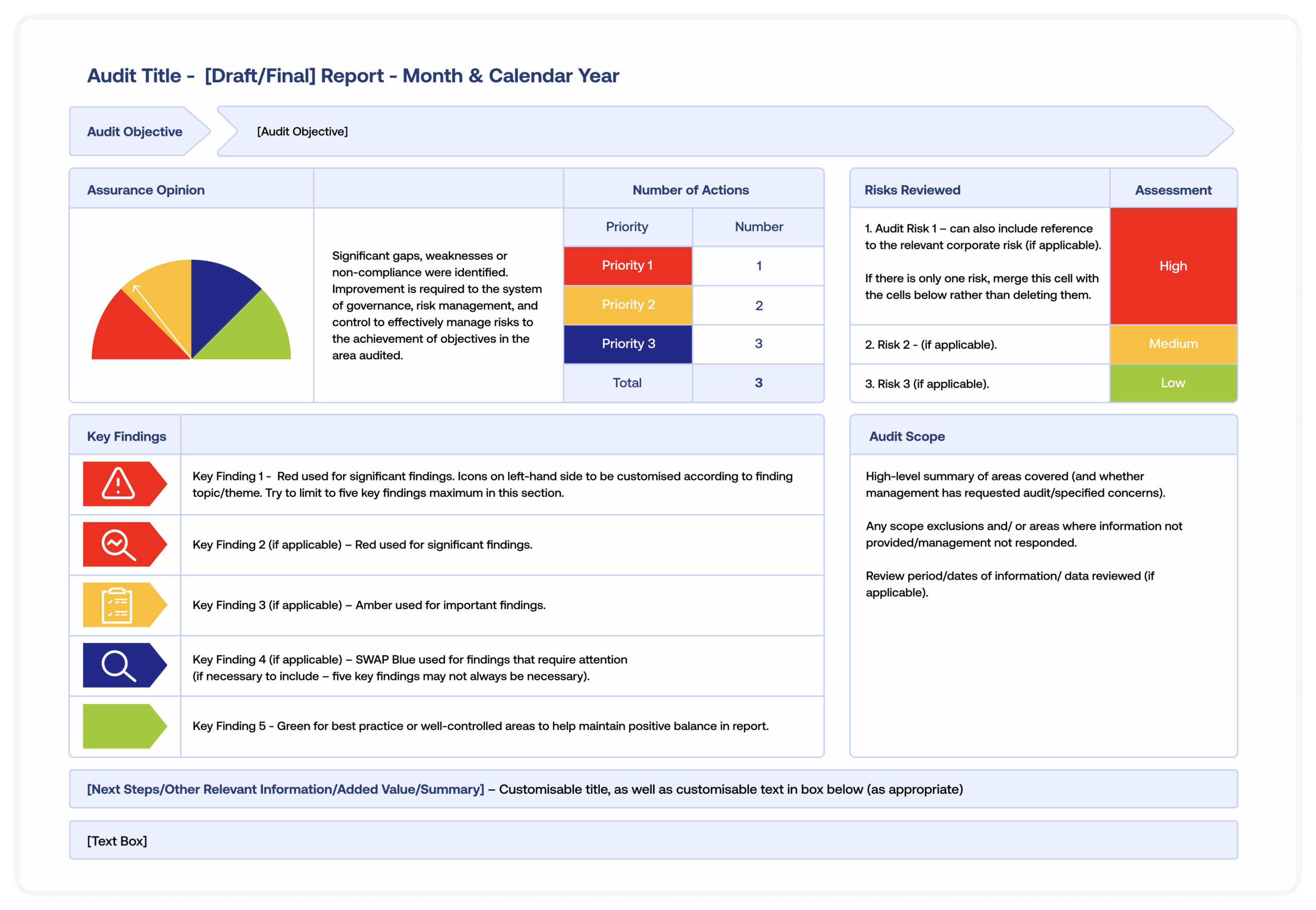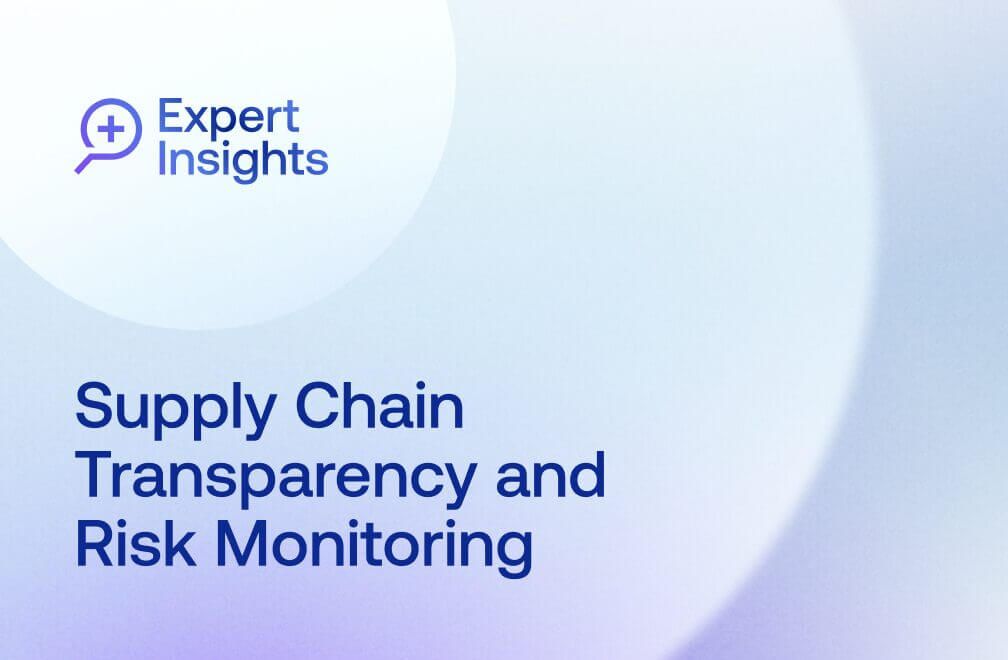
September 28, 2022 • 8 min read
The One-Page Audit Report: Maximizing Efficiency and Elevating Impact

David Hill
The English language is littered with exhortations to keep it “short and sweet.” Shakespeare reminds us that brevity is the soul of wit, while Franklin Roosevelt’s counsel to public speakers is to be sincere, be brief, be seated.
And yet all too often as internal auditors we are at pains to tell the reader or listener everything we did — who, what, why, how, and when — before we get to anything that may be interesting or useful. Unfortunately, our desire to tell all can obscure our message. Linguists call this “verbalism,” but I have another word for it: auditsplaining, or “the tendency of internal auditors to catalogue the unimportant in exhaustive detail.”
There is a real danger we talk ourselves out of a job and that is why at SWAP we have adopted the one-page audit report. It’s been a real game-changer and both our clients and our auditors simply love it. In this article I want to share with you some of our thinking and experiences while encouraging you to try it for yourselves.
What’s Wrong With Long Audit Reports?
I was inspired by a recent LinkedIn podcast by Sarah James called “The Best Way to do Audit Reports.” The trouble with auditsplaining is we can fail in our primary goal of making a difference to our organisations. The IIA’s new strapline is “elevating impact,” which applies to us as individuals and teams of auditors as well as to the professional association. Long audit reports have the opposite effect by cushioning our blows. Here are just a few of the other drawbacks:
- We are creating work for ourselves — writing, reviewing, editing, proofing. Before the new template, our average production rate was roughly one day per page and our reports were around 38 pages, representing seven to eight weeks. We can all do without the additional stress this causes and put this time to better use. Now we are down to 11 days.
- We are delaying communication to the point where our message may no longer be relevant. Circumstances and risks change quickly. Control weaknesses may have already been corrected or got worse. Opportunities may have been missed and losses incurred.
- We are diminishing our brand. Do we want to be known for our elaborate reports or for the impact we have? In his latest book, Agents of Change, Richard Chambers reminds us that, just as the cereal rather than the cereal box is the intended deliverable, so too the organisational improvement we inspire rather than the report we write is our primary product.
The Root Causes of Auditsplaining
I can’t really think of any advantages. If stakeholders are looking for greater detail, it can always be made available. If we are inefficient, we make the audit committee and senior management inefficient. It can take up to four hours to read and digest a 40-page technical report. These are busy people.
Our tendency to provide chapter and verse can come across as insecurity and a need to justify ourselves. There may also be a training issue; writing and presenting skills must be actively developed and continuously improved. We tend to keep doing things the way we have always done them, and often the audit committee and senior management seem satisfied, but that could be because we haven’t shown them anything better. Perhaps we have the wrong kind of relationship and are treated like a contractor rather than a trusted advisor.
Transitioning to the One-Page Audit Report
We sometimes fall into the trap of seeing ourselves as a production line. We have the year planned out in advance divided neatly into quarters and we work systematically to get our reports delivered according to our timeline. Our reports are the chance to let everyone know what we’ve been doing.
What’s needed is a shift in mindset. Our true mission is to make things better by enabling better decision-making. Our work must be aligned with the purpose, priorities, and risks of the organisation. When communicating we should challenge ourselves: is this going to be useful to managers and directors and help them achieve their goals? If not, it doesn’t have any place in our report.
A one-page report is readily consistent with the Standards. We know communications must be “accurate, objective, clear, concise, constructive, complete, and timely” (Standard 2420). We pay too much attention to “complete” and not enough to “concise,” “clear,” and “timely.” The purpose of the report — our added value — is to join the dots for our audience, to interpret what is going on including the implications for strategic goals and the opportunities for improvement. For an idea of our end product, see the example one-page audit report template below.
SWAP’s One-Page Audit Report Template

This is how we have made the transition at SWAP to the one-page report:
- By creating and implementing the concept of a healthy organisation that takes a holistic approach to applying the elements of the Three Lines Model towards a common purpose.
- By shifting our focus from inputs (our work) and outputs (our reports) to outcomes (our impact).
- By consciously adopting an Agile philosophy where we are responsive, flexible, and adaptive, continuously reevaluating priorities and risks and moulding our plans accordingly.
- By taking senior management and the audit committee with us on this journey through continuous dialogue.
- By aligning our planning and resources with organisational needs and priorities.
- By utilising data analytics and best-in-class digital tools to innovate every part of our process.
- By focusing on the bigger picture, drawing on the work of other assurance providers, minimizing duplication, overlaps, and gaps, and utilising the findings of previous audits to inform where we need to be applying our attention next.
- By avoiding auditsplaining in favour of a mature relationship with senior management and the board as a trusted advisor.
Shifting Our Mindset and Approach
I encourage you to try a new approach. You can adopt and adapt our template above or others like it to get you started. If we wish to remain relevant, we have to demonstrate our value by getting straight to the point and providing practical solutions. We can synthesize from multiple inputs and paint a coherent picture, and we can do so concisely. By using technology, metrics, and dashboards we can communicate much more efficiently and effectively. It is our duty to help senior management and the board focus on what’s important now — and into the foreseeable future.
About the authors

David Hill is the former CEO of SWAP Internal Audit Services based in the UK. David has nearly 40 years of audit experience, and is a former member of the Global Guidance Committee. Connect with David on LinkedIn.
You may also like to read


How Uniper achieves greater audit transparency and impact

How Snowflake Uses Continuous Monitoring to Proactively Identify Risk

Enterprise e-commerce company transforms audit planning with Grant Thornton and AuditBoard

How Uniper achieves greater audit transparency and impact

How Snowflake Uses Continuous Monitoring to Proactively Identify Risk
Discover why industry leaders choose AuditBoard
SCHEDULE A DEMO



